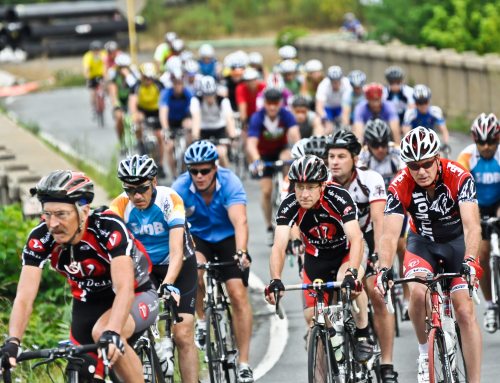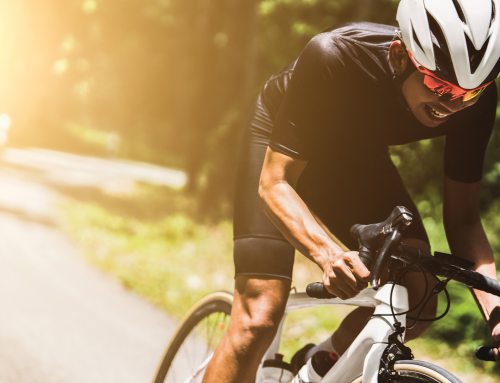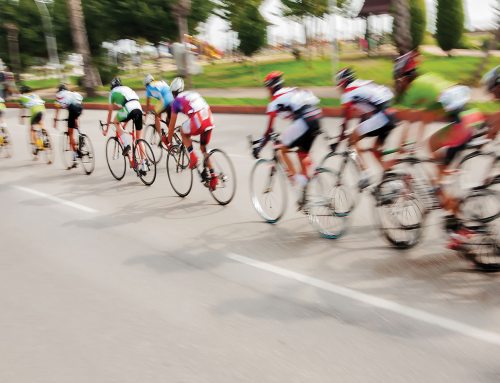By Thomas Henson Jr.
For better or worse, kids are sponges. They soak in the lessons of the world, and then replay them in their own little lives. That’s why it’s important to impart lessons about safety as early as possible, to instill a lifetime of good habits.
I know the basics: I know that kids don’t sit still for “lessons”—that’s too much like work. And they don’t respond well to scare tactics. Warning kids about broken bones or brain injury could simply make your child afraid to ride at all. Instead, allow them to experience the joy of bike riding. Make it something you do together, then set a good example. Kids are excellent mimics. When they are small, they want to do everything you do. If you practice good safety habits, they carry that knowledge into teenage years and beyond.
To learn new tricks for helping safety information stick in tiny minds, I turned to my friend Tom Broyles-Lewis, general manager of Cycling Spoken Here in Cary, North Carolina. Tom knows the secret language that kids hear and understand. Here’s his best advice:
Give kids responsibility for their own helmets
- Let children help choose the helmet. It should fit, but also be comfortable and in a color they choose. If they like the helmet, they’ll be more likely to wear it when you’re not watching them.
- Teach them about the “2-head.” Without a helmet, we all have an exposed forehead. If we put our hand flat across the forehead above our eyes, all four fingers will fit (that’s a 4-head, get it?). With a helmet sitting properly on your head, only two fingers should fit before you are hitting the helmet. Kids love the 2-head helmet check!
- Another way for children to make sure a helmet is sitting on their head properly is to tell them to hold their head steady and look up with their eyeballs. If they can see the visor, the helmet is sitting properly. If not, the helmet is too far back.
- Show children how to respect the helmet. It should never be thrown or kicked. When it is not on a child’s head, it should have a place to “park.” Clear a space on a shelf in the garage, near the bike, where the helmet goes after every ride.
Teach kids about tires
Professionals know that 99% of time, bicycle tires are underinflated. This is a safety issue because underinflated tires won’t touch the ground properly, which could make it more difficult to maneuver well. In addition, it’s easier to get a flat from riding over glass, or from hitting a curb (which kids are always doing).
- Purchase a tire pump with a gauge. Too many parents think they can judge tire pressure simply by squeezing with their thumbs. That’s a highly inaccurate method…and a gauge takes the guesswork out.
- Let children learn how to use the pump (and the gauge). They love it. Soon, they’ll be asking to pump up your tires, wheelbarrow tires, and just about anything else with an air stem.
Explain the importance of proper shoes
- Children (and adults) should only wear sneakers or proper bike shoes. Sandals, flip-flops, and Crocs are too unstable. Feet can get tangled under the bike too easily, leading to smashed or mangled toes.
- Sneakers with laces should always be tied. As an added safety bonus, teach kids to tuck the laces into the side of the shoe to keep dangly strings to a minimum. Tell the little ones this makes them more streamlined, like having ninja feet. They like that.
Hold your own bike rodeo
Many communities hold an annual Bike Rodeo, where kids learn safety skills and demonstrate their cycling proficiency. You can hold your own bike rodeo with your child. All you really need are some traffic cones or chalk to mark the courses, and a large, clear place to ride where there’s no traffic. Set up a fun obstacle course, with areas to do zig-zags and figure-8, and to practice balance, slow rides, and quick braking. For guidelines, see this website from Safe Kids:
https://www.safekids.org/sites/default/files/documents/Bike-Rodeo-Station-Guide.pdf
For more safety activities for kids, visit this site from the National Highway Traffic Safety Administration:
http://www.nhtsa.gov/people/injury/pedbimot/bike/bskitboth/3152bskit/pages/section1/section1toc.html
Visit a bike shop
Like it or not, kids are more likely to listen to advice from other adults than from their parents. The employees of bike shops are “cool boys and girls” who get to play with bicycles all day. So go ahead and defer authority to the folks at the cycling shop—they are happy to be the awesome voice of authority.
Ride safe!
# # #
Thomas Henson Jr. is an avid cyclist, and finds much happiness in bike rides with his family and friends. He leads the complex injury litigation department of HensonFuerst Attorneys. He can be contacted at ThomasHenson@lawmed.com.






